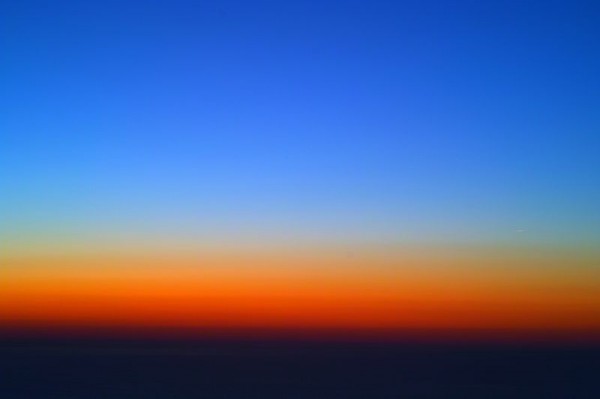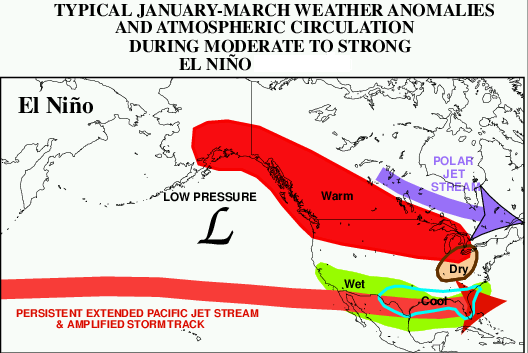Last week, we got a chance to talk about why the sky is red toward sunset and sunrise but blue everywhere else: the atmosphere. Red light passes through the atmosphere pretty well, but blue light gets scattered more easily. When you look to the horizon at sunset/sunrise, the light passes through a tremendous amount of atmosphere, scattering the blue light all over the sky, but allowing the red light through to your eyes.

But then, I got a very good follow-up question:
Sometimes, either at night or in the morning, not just the horizon but nearly the entire sky turns red! Why does this happen, and is the old saying, 'Red sky at night, sailors' delight; red sky at morning, sailors take warning' true?
First off, this is something that really happens. Take a look at a typical "red sky at night", and you'll immediately recognize the difference from what's typical:
So the sky really does turn red all over, either at dawn or dusk, some of the time. But, what could cause so much of the sky to turn red, and what does it have to do with predicting fair or stormy weather?
It turns out that, while air (mostly Nitrogen and Oxygen) will scatter light a little bit, it takes about a hundred kilometers of dense atmosphere to scatter the blue light away. But you know what intensifies light scattering? Dust.

If you have lots of tiny impurities in your air, they can assist with the scattering. Even more of the blue light gets scattered away, reducing the amount of blue you have to see. But this dust will also scatter more red light, sending lots of red light to other parts of the sky. As long as there's something else for the light to bounce off of (like more dust or clouds), you're going to see a spectacular, red sky!
So what causes dust to just stay in the air like this, allowing the sky to turn red? Stagnant, unmoving air. This happens in highly polluted cities, but it also happens naturally over the ocean. All you need is a stable, high pressure weather pattern! High pressure areas mean low chances of rain and storms; generally, they indicate fair weather. When air to the west is stable and high pressure, that means there is good weather coming up, since weather patterns move from west to east.

However, when air to the east is stable and high pressure, that means another weather system, farther west, has pushed that stable, high pressure air off to the east, meaning that lower pressures (and greater chances of storms) are in your future. Additionally, you'll only see the red sky if there is a high content of water vapor in the atmosphere, a further indicator of foul weather ahead:
Amazingly, this old adage has a fair bit of truth behind it, and now you know the science explaining it! Thanks to the Library of Congress (?!) for having some great information on this, as well.
And please, for your own safety, remember that the saying is no excuse for going out on the water unprepared. Not every red sky at night leads to fair weather the next day, and not every red sky in the morning brings storms with it!




Odd you write this, I just came back from a camping trip where the red morning warning came through most days ;).
The trip also confirmed the "not seeing the forest for the trees" saying; looking at the night sky 100 miles from the nearest city in each direction shows so many new stars, that, in combination with some high clouds blotting out key formation identifiers, I was getting lost in the night sky. Never happens in the city where you always get the same patterns of only the strongest lights coming through.
I was under the impression that the saying originated in the tropics, and is related to hurricanes. Hurricanes are massive systems of thunderstorms organized around a central circulation with sustained winds of at least 74 mi/hr, so they have lots of ice crystals, which will scatter light the same way the dust does.
Here's the important detail: In the tropics, hurricanes normally move from east to west; a combination of Coriolis force and steering by midlatitude troughs eventually turns them poleward and then eastward. So in the tropics, seeing red skies in the morning means there is a hurricane east of you which is probably headed in your general direction. If you see the red skies at night, the hurricane is safely west of you and you have nothing to worry about.
Eric, it goes back WAY further than that. According to the Library of Congress link in the post:
So this thing has been around for quite some time.
I always heard "Red sky at night, shepherd's delight, Red sky in the morning, shepherd's warning." (This was in England.)
Your explanation about the dust doesn't quite make sense to me. You say the dust towards the horizon scatters the red light, so it can get reflected back from all over the sky. But the blue(er) light is also still being scattered, right? Why doesn't that also get reflected back from the rest of the sky, or at least from any clouds, giving you white? I think something must be missing from your explanation (perhaps to do with the reflective or light-scattering properties of the rest of the sky).
Incidentally, once many years ago, when an afternoon storm was coming on, I experienced the sky turning a quite distinct (and very ominous) dull green color. Presumably the same sorts of mechanisms are involved, but how do you get green? (And why is it so rare?)
One reason why green is a rare color, not just for the sky but also for many other (non-living) systems, is that green corresponds to a narrow band of frequencies smack-dab in the middle of the visible spectrum. For something to look green, it needs to emit/reflect light within the range of 520-570 nm. If it instead reflects light in the range of, say, 450-550 nm, then it's probably going to look more like cyan or a greenish-blue color.
Compare that with red, which not only covers a wider range of frequencies, but is conveniently located on one end of the visible spectrum. So an object that reflects light in the range of, say, 650-1650 nm will look pure red to our eyes, even though its overall range is wider than the entire visible spectrum.
Ok, another colour question: why aren't leaves black?
If I might add. Volcanoes can add enough dust to the atmosphere to make prettier sunsets all over the world for years after.
http://en.wikipedia.org/wiki/1883_eruption_of_Krakatoa
@Peter: interesting question...
http://en.wikipedia.org/wiki/Chlorophyll
Plants mostly use the red and blue to make energy. Not sure why they leave (pun unintentional, honest) the green light.
@Col. Fazackerley: The chlorophyll molecules absorb red and blue because of their chemical structure, and they reflect the green. That's why the leaves look green: we see the reflected light.
The brilliant fall colors that you see in certain parts of the world (such as northern New England, where I live) are due to pigments that are always there, but hidden by the chlorophyll. In the fall, the chlorophyll breaks down, allowing the other pigments to become apparent.
Let the scientific Salem witch trials begin!
Of course I know about chlorophyll -- we actually have schools up here in the semiarctic North, where icebears roam the streets, what with Denmark being the capital of Sweden or some such.
But why would the plants decide to leave out some of the light? Why leave out the most intense part of the spectrum?
Changing the absorption spectrum to take advantage of more light isn't easy, it means the plant needs to develop a whole series of different chemical structures, each tuned to a different wavelength. There is no such thing as a single organic "broadband" absorber. There's also the energy impact, you absorb too much and you overheat your plant cells. Which means you have to dilute down your absorber, limiting your energy yield by absorber quantity instead of wavelength sensitivity. Much easier for a plant to grab all red with one compound than absorbing selective quantities over the whole spectrum.
Well, this is a pretty cool article. . We both have seen the red skies before, but we never thought about the differences between red and blue skies. Also, we actually can tell whether the weather of a city will be good or bad just by looking at the red sky at night. Before, whenever we looked at the red sky at night, we only think about how pretty the sky is, itâs just so beautiful. But we never had in mind that red skies have more dust, pollution and impurities. And that it might cause bad weather. A beautiful thing does not mean that everything is prefect. We think they are pretty; it might have many negative thing s about them. So sometimes do not be just looked at one thing, like a famous printing, there has many stories about the famous printing that we should know.
Sydney, for instance, had a quite spectacular red dawn the other day. But that was caused by having too much desert in the air...
When I was in the NAVY and we woke to red skies in the morning the weather got ugly and the ship was tossed around in the ocean like a child's toy in a bath tub. But I must admit, that sky was beautiful to look at before the clouds moved in and everything turned black...